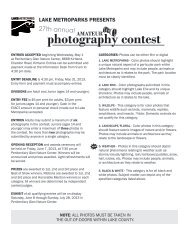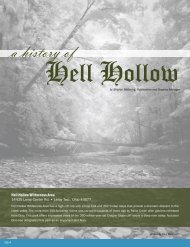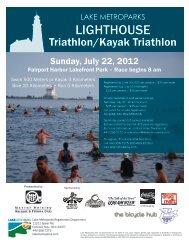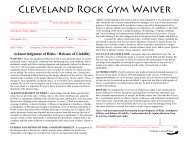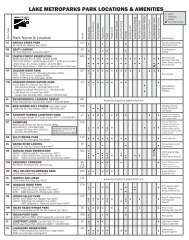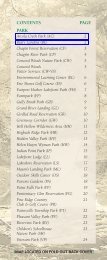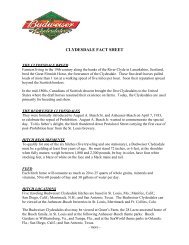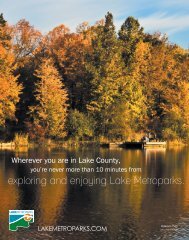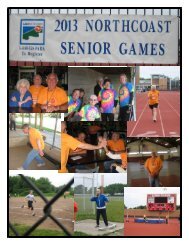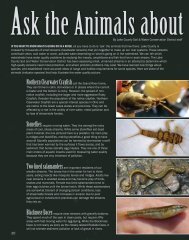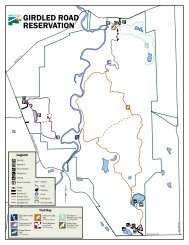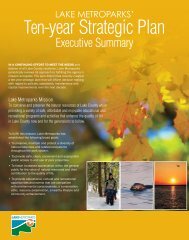Girdled Road Reservation - Lake Metroparks
Girdled Road Reservation - Lake Metroparks
Girdled Road Reservation - Lake Metroparks
You also want an ePaper? Increase the reach of your titles
YUMPU automatically turns print PDFs into web optimized ePapers that Google loves.
Hosea Brown’s Barn<br />
By Andy Baker, Farmpark Administrator<br />
Buschmann Property 1958<br />
Around 1817, Revolutionary War veteran<br />
Oliver Brown, his wife Gracy and son Hosea moved to<br />
Concord, Ohio with Hosea’s young family. Within a year<br />
of arriving they framed up a house and barn, felling the<br />
tall straight poplars to hew into posts and beams. As<br />
they cleared the land, logs were hauled to a local water<br />
powered sawmill on nearby Big Creek to provide boards<br />
and planks. Their three-bay “English” style barn provided<br />
housing for grain, hay and livestock, serving the needs<br />
of the diversified style of farming that Oliver and Hosea<br />
transplanted from New England to the uplands of what<br />
would become <strong>Lake</strong> County.<br />
Hosea and Oliver laid out their 32’ by 42’ barn with the<br />
main door in the longer side wall. The central drive or<br />
threshing bay had large double doors on both ends and<br />
was floored with thick planks. The narrower east bay<br />
was set aside as a cow stable. At the south end of the<br />
east bay, a small door allowed entrance for humans<br />
and cattle. The 19’ deep west bay was used primarily<br />
for storing hay. Lofts above the main drive and the cow<br />
stables were used to store grain and hay. Two small<br />
framed buildings were built to house dried corn on the<br />
cob and threshed out grains.<br />
The Brown family continued to farm the property into the early 1900s.<br />
By the time Hosea’s grandson Fred died in 1926, parts of the property<br />
had begun a slow return to woodland. Hosea’s great grandson Elijah<br />
H. (then superintendent of Harding High School) was an ardent<br />
conservationist, a member of the Audubon society and a founder of<br />
the Blackbrook Audubon Club. He set aside 200 acres of land for the<br />
scouts and nature clubs to use for camping and nature study.<br />
After Elijah died in 1953 without any heirs, the property was purchased<br />
by Arthur and Gladys Buschmann who revived the farm as a stock farm<br />
to raise beef cattle. In 2002, after the death of Gladys Buschmann,<br />
<strong>Lake</strong> <strong>Metroparks</strong> purchased the property. By that time the barn, altered<br />
many times in its 185 years, needed attention.<br />
In 2007, <strong>Lake</strong> <strong>Metroparks</strong> hired a local timber framing specialist, Scott<br />
Carlson to evaluate the barn. Structural problems were evident and<br />
other unseen areas of rot lurked where decades of grass and grain<br />
seeds had encouraged burrowers or held in moisture to begin the<br />
rotting process. The sills, affected by proximity to the ground moisture<br />
had mostly disappeared. It was obvious that restoring the barn would<br />
require deconstruction and then reconstruction. Knowledge that<br />
this was the oldest documented barn in the county added incentive<br />
to the undertaking. In 2008, the construction firm, Union Industrial<br />
Construction, took down the old frame, repaired old beams, hewed new<br />
ones and erected the restored barn frame on its original foundation<br />
stones in its original location.<br />
2008<br />
Today the restored barn stands alone on the landscape<br />
in mute testimony to the story of those settlers who<br />
came to clear the land and settle <strong>Lake</strong> County. Over<br />
the years, the connection of the Brown family to the<br />
land evolved into a conservation ethic that helped<br />
launch the process that now preserves the land for<br />
future generations of <strong>Lake</strong> County residents. Today,<br />
<strong>Lake</strong> <strong>Metroparks</strong> is restoring the old fields to traditional<br />
grasses and providing access across the property with<br />
trails. Standing in the doorway of the newly restored<br />
barn, one can look to the east across the new meadow<br />
and get an appreciation for the view that Hosea Brown<br />
may have had almost 200 years ago.<br />
2010<br />
Five years after his father Oliver died, Hosea listed four<br />
horses, a team of oxen and seven milk cows on the<br />
1850 Census. He raised 35 tons of hay, 20 bushels of<br />
wheat and 55 bushels of oats and 100 bushels of corn.<br />
Other more temporary structures may have housed his<br />
25 other cattle, 25 sheep and four swine.<br />
GIRDLED ROAD<br />
Brown<br />
barn<br />
Brown<br />
Property<br />
1850<br />
2009 disassembly<br />
A few old barns can still be picked out on the <strong>Lake</strong> County<br />
landscape. Many are now surrounded by houses or shopping<br />
centers. With their primary task accomplished (that of housing<br />
the crops and livestock of early Western Reserve farmers),<br />
they were gradually abandoned. Every year a few more<br />
succumb to rotting sills or the moisture eating away beneath<br />
a leaky roof or are torn down to make way for progress.<br />
1915. Much of the Brown land is now part of<br />
<strong>Lake</strong> <strong>Metroparks</strong> <strong>Girdled</strong> <strong>Road</strong> <strong>Reservation</strong>.<br />
20 photo by Tom Adair<br />
21



